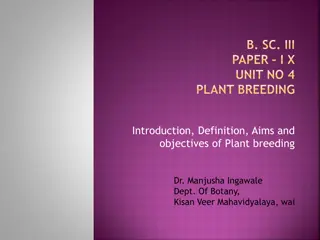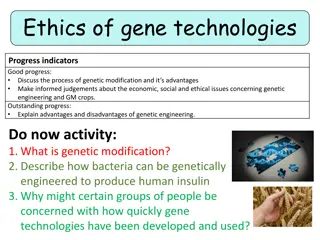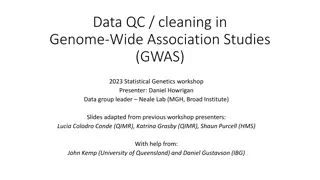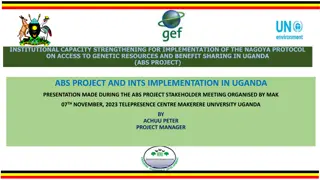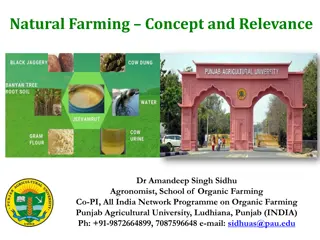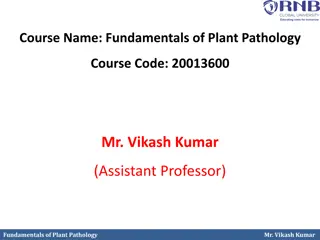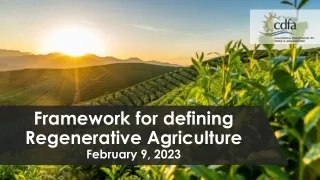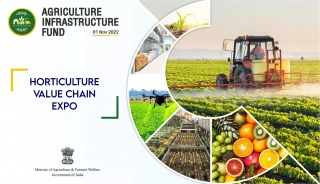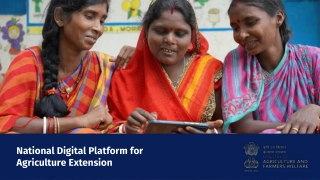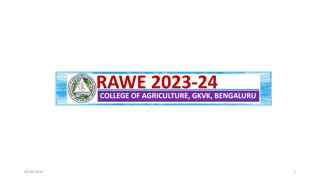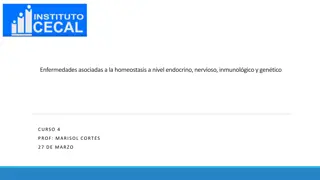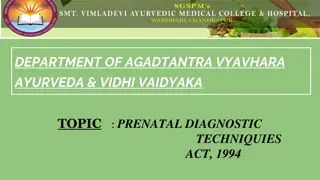International Treaty on Plant Genetic Resources for Food and Agriculture
The presentation to the select committee on Land, Environment, Mineral Resources, and Energy focuses on the importance of plant genetic resources for food and agriculture (PGRFA) in ensuring sustainable agricultural production and food security. It highlights the significance of conserving and utilizing PGRFA to address global challenges such as food security, environmental sustainability, and population growth. The document emphasizes the need for a global policy framework to support the fair and equitable sharing of benefits from genetic resources. It outlines the role of key organizations and the status of South Africa in relevant international treaties and conventions.
Download Presentation
Please find below an Image/Link to download the presentation.
The content on the website is provided AS IS for your information and personal use only. It may not be sold, licensed, or shared on other websites without obtaining consent from the author. Download presentation by click this link. If you encounter any issues during the download, it is possible that the publisher has removed the file from their server.
Presentation Transcript
PRESENTATION TO SELECT COMMITTEE ON LAND, ENVIRONMENT, MINERAL RESOURCES AND ENERGY INTERNATIONAL TREATY ON PLANT GENETIC RESOURCES FOR FOOD AND AGRICULTURE 27 FEBRUARY 2024 1
ACRONYMS : Agricultural Research Council : Convention on Biological Diversity : Community Seed Bank : Department of Agriculture, Land Reform and Rural Development : Department of Forestry, Fisheries and the Environment : Department of Science and Innovation : Food and Agriculture Organization : International Treaty on Plant Genetic Resources for Food and Agriculture : Provincial Departments of Agriculture : Plant Genetic Resources for Food and Agriculture ARC CBD CSB DALRRD DFFE DSI FAO ITPGRFA PDA PGRFA 2
BACKGROUND Plant genetic resources for food and agriculture (PGRFA) consist of diversity of seeds and planting material of traditional varieties and modern cultivars, crop wild relatives and other wild plant species. o crucial for sustainable agricultural production o provide the biological basis for food security and supporting economic livelihoods, particularly of rural communities o diversity of crops conserved to provide for current and future use by farmers, breeders and researchers o used as food and feed for domestic animals. 3
BACKGROUND Global recognition of the contribution of plant genetic resources for food and agriculture in the enhancement of food security. The loss of these resources poses a severe threat to the world s food security in the long term. The conservation and sustainable use of PGRFA is critical to safeguard crop production and meet environmental challenges and population growth. 4
Global Policy Framework: Conservation and sustainable use of genetic resources; Fair and equitable sharing of benefits arising from their use International Treaty on Plant Genetic Resources for Food and Agriculture (ITPGRFA): South Africa is not a Contracting Party Convention on Biological Diversity (CBD): South Africa is a Contracting Party Department of Agriculture, Land Reform and Rural Development Department of Forestry, Fisheries and the Environment National Environmental Management: Biodiversity Act, 2004: excludes plant genetic resources listed under the ITPGRFA Some of the ITPGRFA activities conducted by the National Genebank 5
THE NATIONAL GENEBANK: DIRECTORATE GENETIC RESOURCES (BRANCH: AGRICULTURAL PRODUCTION, BIOSECURITY AND NATURAL RESOURCE MANAGEMENT) The National Genebank was established in 1995 Ex-situ and in-situ (on-farm) conservation of PGRFA Ex-situ collection: Approximately 6 202 accessions The majority of the accessions belong to: cucurbits 18.5%, beans- cowpea, bambara (16.2%) maize (15%) and sorghum (5%) 6
THE NATIONAL GENEBANK: DIRECTORATE GENETIC RESOURCES (BRANCH: AGRICULTURAL PRODUCTION, BIOSECURITY AND NATURAL RESOURCE MANAGEMENT) Ex situ conservation: Collection and Acquisition of material Processing of material--assessing the quantity, viability, health of samples Germination testing Multiplication and characterisation Documentation Long term storage in a cold store, laboratory or in the field Provide access to farmers/communities and researchers 7
THE NATIONAL GENEBANK: COLLECTION MISSIONS FOR PGRFA LIMPOPO & NORTH WEST PROVINCES 8
THE NATIONAL GENEBANK: MULTIPLICATION AND CHARACTERIZATION 9
THE NATIONAL GENE BANK: STORAGE -18 C -18 C between 4 C and 7 C -18 C between 20 C and 28 C 10
THE NATIONAL GENEBANK: DIRECTORATE GENETIC RESOURCES (BRANCH: AGRICULTURAL PRODUCTION, BIOSECURITY AND NATURAL RESOURCE MANAGEMENT) In situ/ On-farm conservation On-farm multiplication Community Seed Banks (CSB) Seed diversity/food fair Participatory Plant Breeding Program 11
PARTICIPATORY PLANT BREEDING Farmers identify crop and traits of interest Pearl millet, Okra, Cowpea and Sorghum 15
THE OBJECTIVES OF THE INTERNATIONAL TREATY ON PLANT GENETIC RESOURCES FOR FOOD AND AGRICULTURE The International Treaty on Plant Genetic Resources for Food and Agriculture (ITPGRFA) was adopted by the FAO Conference at its Thirty-first session in November 2001. Aims at guaranteeing food security through the conservation, exchange and sustainable use of PGRFA. The objectives: othe conservation and sustainable use of plant genetic resources for food and agriculture, oand the fair and equitable sharing of benefits arising from their use, in harmony with the Convention on Biological Diversity (CBD), for sustainable agriculture and food security. 16
OBJECTIVES OF THE ITPGRFA Article 9: orecognises the contribution that the local and indigenous communities and farmers have made and will continue to make for the conservation and development of plant genetic resources which constitute the basis of food and agriculture; oprovides for the protection of traditional knowledge relevant to plant genetic resources for food and agriculture; oprovides for the right of farmers to participate in making decisions, at the national level, on matters related to the conservation and sustainable use of plant genetic resources for food and agriculture. 17
CONTRACTING PARTIES The Treaty has 145 Contracting Parties, including 13 from the SADC Region Contracting Parties agree to provide facilitated access to PGRFA of 64 crops and forages included in Annex I of the Treaty for conservation and utilization, research, and breeding for food and agriculture South Africa has not yet acceded to the Treaty: o the developments around the Treaty in view of the attainment of goals of the Treaty o the benefits emanating from being Contracting Parties o Multilateral System of Access and Benefit-Sharing In February 2018, the then Minister of Agriculture, Forestry and Fisheries granted approval for the Department to re-initiate the process toward South Africa s accession to the Treaty. 18
STAKEHOLDER CONSULTATIONS October 2018: initial consultation - national stakeholder workshop September 2019: Legal opinion from Office of the State Law Adviser February 2020: Legal opinion from DIRCO November 2020: an official invitation for public comments on South Africa s accession to the Treaty published in Government Gazette 15 December 2020: Closing date for public comments, extended to 15 January 2021 COMMENTS FROM: o Government departments/entities: DFFE, DSI, Agricultural Research Council (ARC), South African National Biodiversity Institute (SANBI) o Civil Society Organizations: Africa Centre for Biodiversity, Biowatch o South African Seed Organisation (SANSOR): 118 seed companies o Individual companies: Syngenta, Bayer, Rijk Zwaan 19
STAKEHOLDER CONSULTATIONS General support that South Africa accedes to the Treaty. Acknowledgement that the Treaty was a very important instrument: o as it recognises farmers practices and the role played by farmers in conservation of plant genetic resources and agriculture; and o the rights of farmers to save, use, exchange and sell farm saved seed. Legal Opinions: o confirm that the Treaty is not in conflict with the domestic law of the Republic of South Africa 20
RATIONALE Acceding to the Treaty will support the National Development Plan and government s objectives and priorities such as sustainable management and use of natural and biological resources and rural development. The Treaty recognises the current and future contributions of local and indigenous communities and farmers development of plant genetic resources. towards conservation and South Africa will therefore accordingly ensure the protection of traditional knowledge, the right farmers to participate equitably in benefit sharing and decision-making regarding plant genetic resources for food and agriculture. There are rigorous global negotiations on the Multilateral System of Access and Benefit-Sharing on utilization of plant genetic resources for food and agriculture. It is prudent for South Africa to be a part of these negotiations, in order to safeguard the country s interests in as far as the conservation of plant genetic resources for food and agriculture as well as access and benefit sharing for their utilization is concerned. 21
IMPLICATIONS Constitutional Implications Treaty falls within the ambit of section 231(2) of the Constitution of the Republic of South Africa, 1996, requiring parliamentary approval for ratification. o Financial implications The Treaty is funded through a Funding Strategy: voluntary resources allocated by governments for their own domestic activities other resources that are deployed by international organisations such as the Crop Trust programmes on conservation and sustainable use of plant genetic resources funded under the departmental MTEF allocation. o Human Resources and Organisational Implications o National Genebank of South Africa (DALRRD) is already in place. o No additional human resources required o Strengthening of the National Genebank s capacity and infrastructure is needed to ensure the effective implementation of the ITPGRFA 22
IMPLEMENTATION PLAN DALRRD o National genebank o National programmes on ex situ and on-fam conservation and sustainable use of plant genetic resources for food and agriculture o National Plan on Conservation and sustainable use of plant genetic resources for food and agriculture o Collaboration with PDAs on establishment and maintenance of Community Seed Banks o Collaboration with ARC on participatory plant breeding initiatives Mutual implementation with: o National Environmental Management Biodiversity Act: Legislation on Access and Benefit Sharing administered by DFFE o Indigenous Knowledge Systems Act: Legislation on protection, promotion, development and management of indigenous knowledge administered by the DSI 23
RECOMMENDATION It is recommended that the Select Committee on Land, Environment, Mineral Resources and Energy considers the this briefing on the International Treaty on Plant Genetic Resources for Food and Agriculture and possibly process it further through other Parliamentary processes. 24







